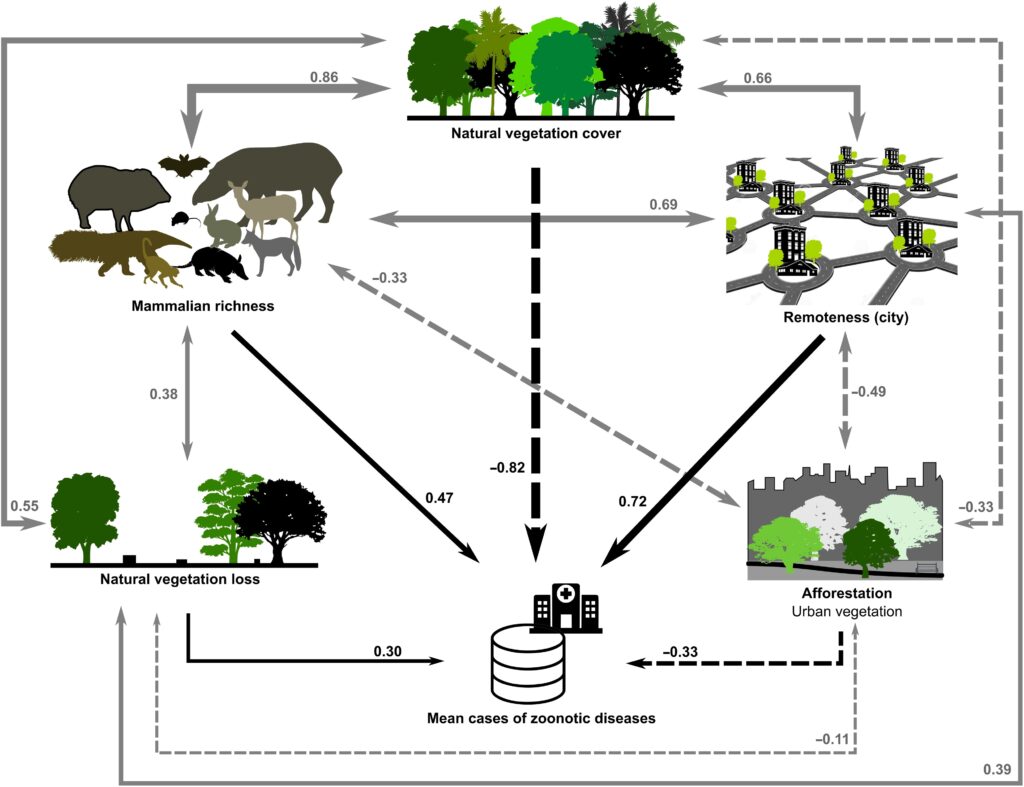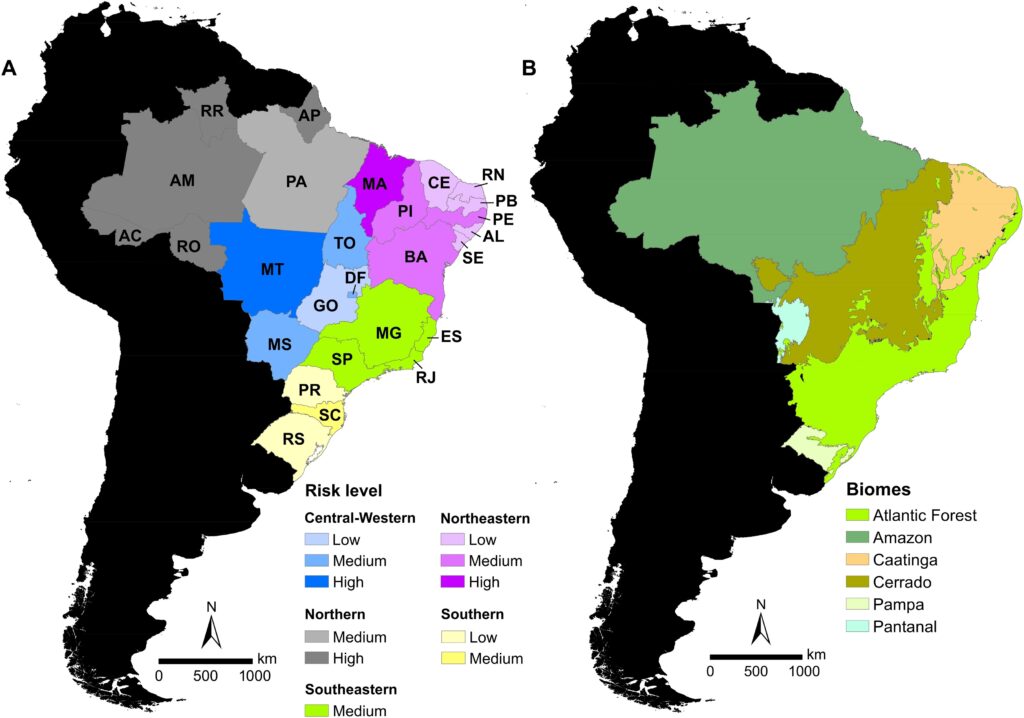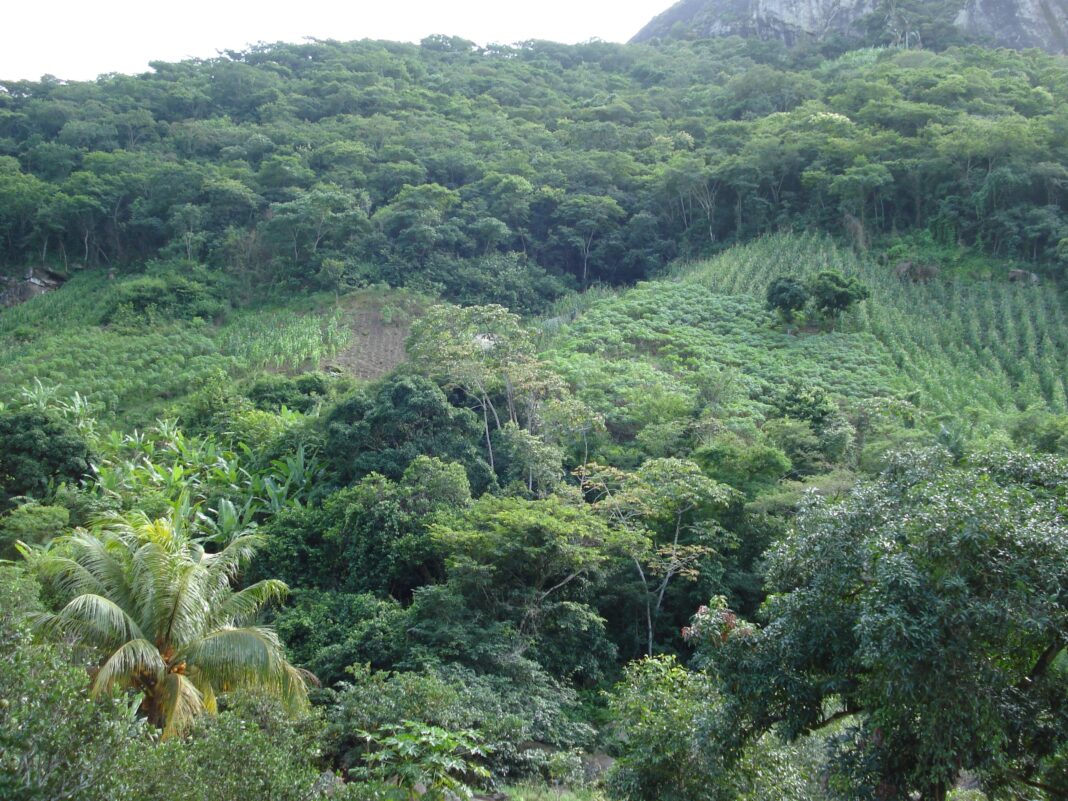Since the outbreak of COVID-19, the surveillance around zoonotic diseases has increased globally due to its potential to become the next pandemic.
A research article published this week in Science Advances suggests that the increasing environmental and social vulnerabilities— plus the economic and political crises— in Brazil could lead to the emergence of native zoonotic diseases.
Scientists from Brazil and Portugal used a novel risk assessment method that considered several drivers for this kind of infection, such as changing land-use patterns, the richness and diversity of terrestrial mammalian species, the social welfare and the geographical connectivity of cities and towns. This approach is based on early studies that provided evidence about the link between the occurrence of outbreaks and similar ecological, socioeconomic, and demographic processes, such as rapid deforestation and urbanization, conservation policies, and human demographic flows.
The study headed by G. Winck, from the Oswaldo Cruz Foundation in Brazil, sheds light on how the interaction between wildlife and humans could generate zoonotic diseases and discusses the implications for public health policies.
The team collected data from about nine zoonotic diseases in the region between 2001 and 2019, such as Chagas, yellow fever, and malaria. “We assume that the processes underlying the geographical spread and epidemiological patterns of these zoonoses could be extrapolated to novel pathogens emerging from wildlife,” the researchers pointed out.
They focused on understanding how anthropogenic pressures on ecosystems and social vulnerability promote risks from contact between people, domestic animals, and livestock. The zoonotic pathogens circulating in wild terrestrial mammals that are highly tolerant to human presence can become epidemic agents.
Several authors have already raised red flags on the risk of a deadly pathogen emerging from the Amazon rainforest due to changes in land-use patterns. This phenomenon increases social vulnerability, disrupts ecosystem functioning, and affects pathogen transmission cycles. It broadens the contact between humans and previously isolated wildlife, pathogens and vectors’ hosts.
Mapping Brazilian epidemic risk
The findings show that zoonotic epidemic risks are associated with vegetation loss, mammalian richness, and remoteness. Urban afforestation—the practice of planting trees into cities—and vegetation cover do not correlate with their emergence.
The scientists mapped the zoonotic epidemic risks for each Brazilian state. According to the model, from 27 states, almost 70% are in danger of a zoonotic outbreak.
The Northern region has the highest risk level, specifically: Acre, Amapá, Rondônia, Roraima, Amazonas and Maranhão, and one state from the Central-Western, Mato Grosso. This group includes the lands with the highest vegetation cover -Amazonas- and the one with the highest vegetation loss -Mato Grosso-.
The Amazon rainforest partially or entirely covers these places. They have the lowest levels of urban forestation, the highest mammal richness, and the highest levels of city remoteness. The results support previous studies confirming the correlation between the Amazon rainforest habitat and the major concern regarding zoonotic illness.
Northeastern and Southern are the regions with the lowest risk. Usually, these cities have little vegetation cover and loss, and higher levels of urban forestation. Furthermore, the connectivity among towns is good and access to large urban centers and specialized health care is easier.
The human mobility pattern in Brazil—people moving from small villages to larger cities for services, goods, business and sometimes healthcare—amplifies the potential spread of a zoonotic spillover disease.

Bushmeat hunting and trading as relevant factors
Bushmeat hunting is another relevant factor for emerging zoonoses because of the direct human–wild animal contact. In Brazil, this practice is cultural and widespread across all regions. Researchers created a dataset with the most frequent hunted mammal species and their parasites, potential zoonotic agents.
They found 173 parasites in 63 mammals, which can cause at least 76 different diseases. The protozoans Leishmania, which induces Leishmaniasis, and Trypanosoma, which causes Chagas, live in many species. The crab-eating fox, usually killed for control, the peri-urban opossum species, and the armadillo group—highly appreciated as bushmeat—, have the highest number of different parasites. The Capuchin monkey exclusively hosts hemorrhagic fever viruses.
“To prevent zoonotic outbreaks related to hunting, it is imperative to ensure the sanitary and food safety of people who use bushmeat for their subsistence, through health monitoring of the whole production chain and policies promoting education in good management practices,” the team advises.
All regions in Brazil are at risk
To date, foreign pathogens such as dengue and yellow fever have been causing major disease outbreaks and epidemics in Brazil. However, the findings confirm that all regions in Brazil are subject to zoonotic risks emerging from the native biota.

The researchers of the new study indicate that, after the experience of the COVID-19 pandemic, strategies preventing outbreaks of novel viruses should be a priority for public policies worldwide.
They argue that the current challenge in Brazil is to integrate both ecosystem/landscape -mammalian richness, vegetation loss, and vegetation cover-, and urbanization – remoteness and urban forest- in the planning of public health policies. G. Winck and his team advise laboratory confirmation of zoonotic agents in wildlife, livestock, and humans. Moreover, they emphasize the importance of informing the Brazilian population about the risks of these illnesses through educational programs for individuals, families, and communities.
Finally, they highlight that in megadiverse countries with high social vulnerability and growing environmental degradation, such as Brazil, preventive strategies for zoonotic disease outbreaks require collaboration among different sectors, including the federal government, agribusiness, and society.
References
Socioecological vulnerability and the risk of zoonotic disease emergence in Brazil. 2022. Winck, G. W. et al. Science Advances. DOI https://doi.org/10.1126/sciadv.abo5774
A ‘One Health’ Approach to Predict Emerging Zoonoses in the Amazon. Conference: 1a Conferência Brasileira em Saúde Silvestre e Humana – Saúde silvestre e humana: experiências e perspectivas At: Rio de Janeiro, Brazil. 2012. Uhart M. et al. DOI 10.13140/RG.2.1.3549.1609
Major environmental and socioeconomic determinants of cutaneous leishmaniasis in Brazil – a systematic literature review. 2020. Lia Puppim Buzanovsky, Manuel José Sanchez-Vazquez, Ana Nilce Silveira Maia-Elkhoury, Guilherme Loureiro Werneck. Sociedade Brasileira de Medicina Tropical – SBMT. DOI 10.1590/0037-8682-0291-2019





